Category ArchiveArticles on Animation
Animation Artifacts &Articles on Animation &Guest writer &Photos 13 Aug 2008 07:51 am
Irv Spector – I
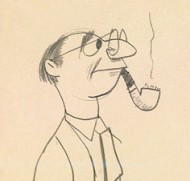 – Not too long ago, Paul Spector and I had an email conversation about his father, Irv Spector.
– Not too long ago, Paul Spector and I had an email conversation about his father, Irv Spector.
Irv was an animator that I knew periferally in New York during my first days in animation. We saw each otherat Union Meetings and some animation events in New York, but I didn’t really know about his start and key days in the business.
I jumped at the chance to ask Paul to share anything, anytime with this blog, and I’m pleased and excited to post this first entry from him.
__(Click any image to enlarge it.)
In 1941, during WWII, my father was an animator at Flesicher Studios in Miami, FL. At the the time, many cartoonists were being drafted into, or enlisting in, the miltary. Knowing he would soon be one of them he left Florida and drove across the country back to Los Angeles — where he was already registered for the draft — to push up his induction. (He began his career in LA at Mintz and Schlesinger, before taking a job with Fleischer when they were still located in New York).
Like a lot of other cartoonists my dad was assigned to the animation unit of the Signal Corp, making training films and other industrials; in his case back at the east coast unit.
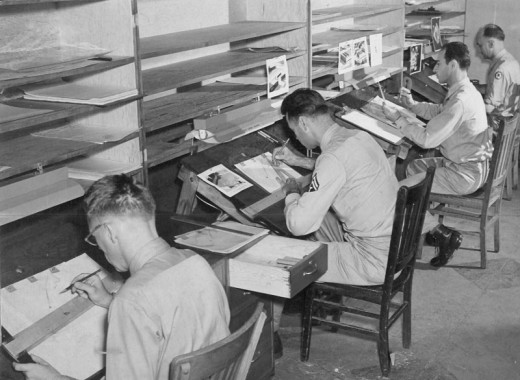
In this photograph, my father is second from the right.
While many of these films incorporated animation as well as live action and photography it was not just those in the animation field who worked in the Corp. Although those of us with an interest in the animation field tend to focus in on that aspect, the Corp also produced pamphlets and manuals, etc. One of these non-animation inductees was Sam Cobean whose illustrations appear in many of the images below. Some of the most striking are done by him. A quick note about Cobean: during the war he was taken under the wing of The New Yorker magazine cartoonist-extradinaire Charles Addams, who introduced him to the editors at the magazine. Cobean soon began publishing there, and his star rose quickly through the post-war years until he was tragically killed in an automobile accident in 1951. The majority of those below came out of a manila envelope with “Sam Cobean, Bob Perry, Others” written on it. Several others were from untitled envelopes. Very few are signed by the artists, although you’ll notice several that are, especially two straighter drawings by the magnificient Lars Colonius. However, the vast remainder are pretty much gags and caricatures. Mostly funny, ludicrous, or just really nice to look at.
Some poke fun at army life, but most of all they lampoon my dad, who appears in almost all of them along with a cast of other cartoonists in the unit. (But whose else would I have? Naturally, about 98% of what I have is his work. This is the other 2%). The joke in some of these is that my father began to lift weights in the army, hence the drawings where he is muscled, or the mention of “Spector’s Health Roof”, or referred to as Simian(!) Here is are some real photographs of my dad in those years, so you can get a fix of what he really looked like then. Make sure you scroll down, and maybe someone out there can identify the three other gents in the image of them sitting along a wall (my father is second from right, with his eyes closed.)
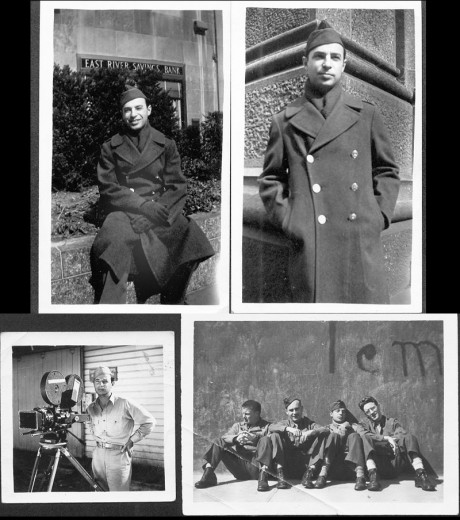
Irv Spector
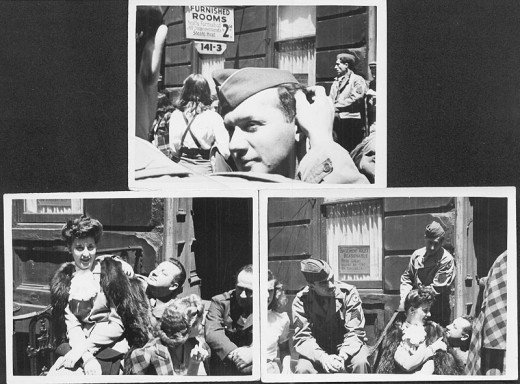
I’ll leave it up to all of you to try and identify anyone depicted throughout. One who is obvious to me is animator Herman Cohen, a longtime friend of my dad’s and our family in general. Here are some photographs on him — that’s his wife Juliet sitting on his lap.
An anecdote about Herm: In the mid-late 1960s, Herm and one of his sons, and my dad and myself, were shooting pool at our house. On one of Herm’s turns, we watched him take his cue stick and line it up by the 1-ball, sizing up angles. However, when it was time to take the shot, he actually hit the 1-ball with his cue — as if it were the cueball — to sink another ball. A moment later my dad says, “Hey, I forgot all about it. Herman is color blind!” Yep, Herm mistook the solid yellow 1-ball as the cueball. Just goes to show there’s hope that you too can have a lifetime career as a respected animator without being able to identify colors.
(Here are a few more of Irv’s caricatures of the period.
None of them have any background info on them.
If you can ID any of the people, please feel free to comment. MS)
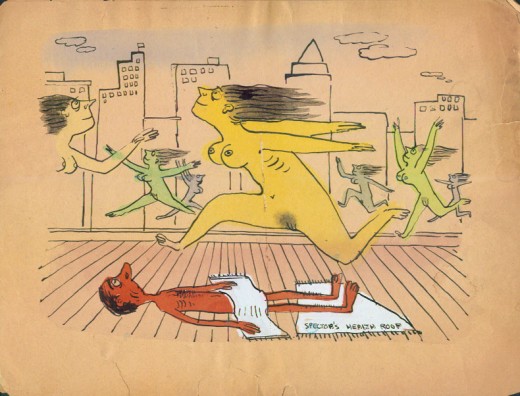
Health Roof
For the historians out there: There seems to be a dearth of information on the internet regarding the Signal Corp Animation Unit, east coast and west. If it helps, I’ve pieced together some of my father’s own moving around — date-wise, using some of the mail he received during this time. Maybe this info can be extrapolated…I dunno, but perhaps it can help.
- April 1942: Bob Givens (also in the service) writes him at Ft. Monmouth, NY (from Ohio).
August 1942: Givens writes him c/o of the Signal Corp Animation Unit at Long Island City, NY (no return address).
September 1942: Jack Rabin (just about to be inducted) writes to him at the Training Publications Dept. of the Anti Aircraft School, Camera Crew Unit #1, at Camp Davis, NC.
July 1943: Written to at the Signal Corp Photographic Center on E.32nd St., NYC, NY.
Jan/Feb, 1944: Carmen Eletto writes to him, again at the Signal Corp Photographic Center on E.32nd St., NYC, NY.
Here’s an undated item from the TAG blog. Givens is in it, at Ft. Monmouth. So, pre-April ’42 maybe? Before he was shipped out to Ohio, of all places.
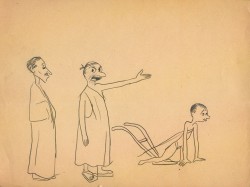
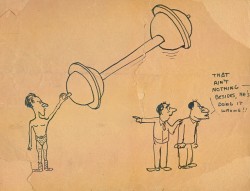
More images will follow on Friday.
Articles on Animation &Commentary &Guest writer &Independent Animation 12 Jul 2008 08:23 am
Guest writer: Why Cartoons?
 – I received the following article from Nina Paley, the creator/animator/ director/designer of Sita Sings the Blues (which won the Best Feature Prize at Annecy this year.) The article came with a letter, which I think helps explain why she wrote it.
– I received the following article from Nina Paley, the creator/animator/ director/designer of Sita Sings the Blues (which won the Best Feature Prize at Annecy this year.) The article came with a letter, which I think helps explain why she wrote it.
Here’s the letter:
- Hi Michael,
I’m back in NY, finally, spending my first day home in my apartment with the AC on with the cat next to me, surfing the web. I read your review of Wall-E, which I haven’t seen yet, and thought to send you this essay I wrote for Frederator (which they never used) on the theme of “Why Cartoons?”.
Since Berlin, I’ve been convinced that most cinemagoers are simply voyeurs, craving simple stimulation of their primate visual senses in the form of close-up views of beautiful people courting and mating, and gory violence. Things our inner primates think about constantly but seldom get to see. Animation is more abstract and cerebral, visually. I prefer it to live action, but I am a freak (like most animation fans).
Pixar’s success lies in making animation that visually resembles live-action and satisfies the typical cinemagoer’s inner voyeur. Hence the expanding popularity of 3D “animation” among Hollywood producers.
Typical American cinemagoers are put off by 2D animation, but 3D gives them more of what their primate eyes want: to believe they’re watching real events up close without risking personal exposure.
Since I’m going to a lot of festivals with “Sita,” I am struck by the cultural differences between animation festivals and “real” film festivals. When I refer to films as “live-action,” most directors don’t know what I’m talking about; to them live-action is just “film,” and animation is completely off their radars. Most have never heard of Annecy or any other animation festivals. Most film festivals automatically exclude animation from competition, instead programming it in what I call the Animation Ghetto – or worse (in the case of “Sita”), the “Family” or “Children’s” sections. But their programming animation at all is evidence of some progress. And I’m grateful, especially for the 2D animation fans that already exist, and the chance to expose new viewers to the art form.
Hope you’re well,
–Nina
This is the article she sent.
- WHY CARTOONS?
Because less information = more meaning
Animation takes advantage of quirks of human perception. Good cartoons lie somewhere between nature (no abstraction) and text (full abstraction).
At its best, animation does what live action can’t. Good animation is unrealistic. This starts with the style itself: drawings and designs of things that can’t exist in the real world. Exaggerated heads and hands, huge or tiny eyes, rubber-hose limbs, cubism. A handmade line drawing of a robot requires our uniquely human imaginations to understand it as “a robot,” but we may recognize it more quickly than a photograph of a real robot.
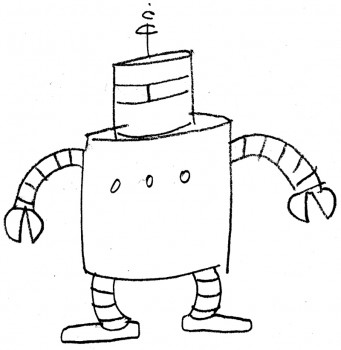
Exhibit A: cartoon drawing of a robot.
Animated motion should also defy reality. For example, bouncy walks that no robot (or human) could replicate, even though we can recognize them as “walks.” Good cartoons stimulate and exercise our imaginations in ways live action never can.
Like reading or working out, viewing cartoons can be exhausting. But far less time is needed to communicate more meaning. That’s why cartoons are so effective as shorts (and commercials).
Live action conveys too much information. “High production values” are the art of removing as much information from nature as possible.
Wrinkles and blemishes on actors’ faces are concealed with makeup; stray threads and hairs are tucked away by stylists; wires and microphones hidden through camouflage, meticulous set design and framing; unwanted details lost in shadows via careful lighting, which heightens only those few areas and outlines intended to convey meaning. But still, excessive information abounds in live action.
Cartoons start with only the information needed. There’s nothing extraneous to hide. If you mean “eyes,” you show a symbolic short-hand representation of “eyes,” nothing more. No gunk in the corner of the eyes, no moles on the eyelids, no eyebrow dandruff – unless you explicitly intend to convey these details as well. The picture is as clear as the idea in the mind of the artist, and that clarity of meaning is transferred to the viewer.
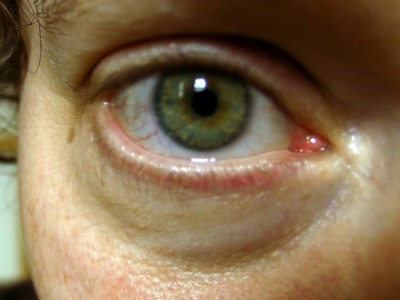
Exhibit C: real eye, belonging to the author.
Notice bloodshot veins indicating stress, wrinkles indicating wisdom and maturity,
shiny skin surface indicating absence of makeup, and other excess information.
(Also, producing animation totally trumps live action: No uppity actors. No obnoxious crew. No permits. No tedious laws of physics. If you can imagine it, you can animate it; no extra charge.)
But animation remains the bastard child of cinema. Most moviegoers just want to watch beautiful people. Bonus if the beautiful people are celebrities; extra bonus if the beautiful people are performing sex or violence onscreen. Animation can deliver meaning, story, ideas – but it doesn’t satisfy the sexual voyeur that drives most cinephiles. In live action, a camera can linger for minutes on a beautiful actress’ face, as the audience attends to all that information: every eye-blink, every change in pupil dilation, the subtlest nostril flare, the slightest movement of any of the hundreds of facial muscles lurking below the makeup. In live action, such a scene is watchable. How could such a serious and pensive scene be conveyed in animation? It would either be painfully dull (a long still) or ridiculous (imagine a Bill Plympton interpretation where every nuance is exaggerated: small nostril flare becomes huge, facial muscle twitch becomes twitchy animal running around under skin) and, like all animation, exhausting.
Live action satisfies our voyeurism, animation ridicules it.
Since I can’t take voyeurism seriously, I go for ridicule.
Animation Artifacts &Articles on Animation &Richard Williams 13 Jun 2008 08:03 am
Dick’s Notes
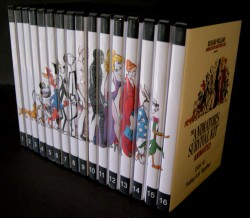 - Thanks to The Thief blog, and further discussed by Mark Mayerson, information is out there about Richard Williams‘ new site for his Masterclass set of dvds.
- Thanks to The Thief blog, and further discussed by Mark Mayerson, information is out there about Richard Williams‘ new site for his Masterclass set of dvds.
Dick’s website is very informative and gives an extended promo tour of the dvd’s showing a longish segment. Take a visit even if you don’t plan on buying the instructional set which is currently selling for $999.
Of course, Dick’s companion book is still available. The Animator’s Survival Kit is for those who still can read and comprehend from the written word. The book also comes with pictures, but they don’t move like the dvd does. It’s only $20 in paperback, though.
Years ago – and I mean years ago – Dick brought gifted animation stars to his studio to lecture the British crew. He put together a set of notes for Art Babbitt’s lecture series that took place July 1973. When Raggedy Ann was in production, Dick had offered us all copies of his notes. It’s a big volume, and it involved extensive photocopying. I don’t think it took long for this book to make it all across the animation industry. Everybody seemed to have owned a copy. This was certainly Dick’s credo – to promote good animation.
Dick also had another notebook that was larger. 11 x 14 copies were even harder to photocopy, but this book seemed clearer and more planned. It was also not distributed as widely. It was obvious that Dick was looking to write a book, and this was its predecessor.
I have copies of both, and they’re very different. I thought I’d celebrate the promotion of Dick’s new dvd’s by posting one of the chapters from the Art Babbit Lecture series. It’s a bit hard to follow, but if you make the effort, you’ll find a lot to learn. These WERE essentially Dick’s notes on Art’s lectures; they weren’t designed to teach.
Articles on Animation &Disney 07 Jun 2008 08:53 am
Palmistry
- Reading palms can probably tell you a lot about people.
LIFE Magazine, back in Dec 13, 1937, decided to see what they could learn from the palms of a number of celebrated people.
_________________Let’s see what they had to say about Walt Disney‘s palms.

_____________________________________(Click any image to enlarge.)
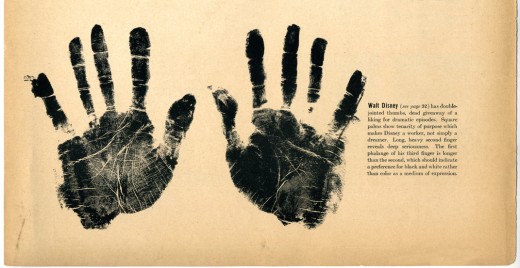
________This is the full layout of the piece. I’ve split it for better sightseeing, below.
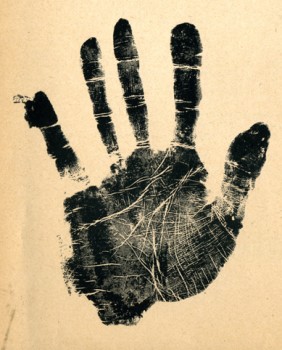 __
__
Yet again, this magazine article came courtesy of John Canemaker and his invaluable collection. Many thanks to John.
 - Speaking of good palms, let me promote the gallery opening and congratulate my good friend, Lew Achenbach.
- Speaking of good palms, let me promote the gallery opening and congratulate my good friend, Lew Achenbach.
His show “Spirit Animals, Contained Chaos and Actuality” will run from June 13th through June 27th. There’s an opening reception on Friday June 13th from 5-8pm.
The website is here.
The show is located:
Upstairs in the Historic Temple Theare Building
at 628-632 Centre Street
Ashland, Pennsylvania
The art, like the artist, is certainly going to be modern.
Animation Artifacts &Articles on Animation &Disney 05 Jun 2008 08:16 am
LIFE with Alice
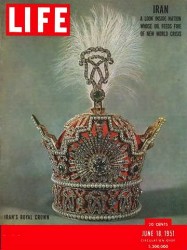 - I’m going to put together a couple of posts on Disney’s Alice In Wonderland, and I think this LIFE Magazine article from June 18, 1951 is an excellent place to start.
- I’m going to put together a couple of posts on Disney’s Alice In Wonderland, and I think this LIFE Magazine article from June 18, 1951 is an excellent place to start.
It’s interesting that they call the article, “Alice In Disneyland.” This is one of the first references to “Disneyland” that I’ve noticed. There was a TV show done for ABC, “One Hour In Wonderland,” a 1951 Christmas show which promoted the heck out of the movie. Kathryn Beaumont, dressed as Alice, got to parade around with lots of kids. This show probably served as the prototype for the “Disneyland” TV series, but made no reference to the name of the future theme park.
This article comes from John Canemaker‘s the collection, and I have to thank him for his contribution, _____(click any image to enlarge.)
yet again.
I’ve chosen to leave any periferal ads in there, for context and amusement.
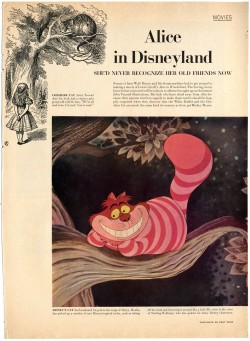 1
1 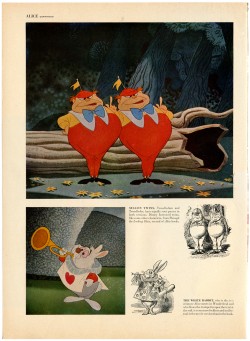 2
2
Articles on Animation &Disney 22 May 2008 08:20 am
Bambi’s Music 2
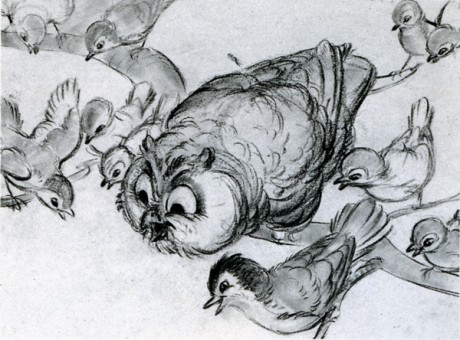 - This is the completion of Ross Care‘s article on the musical score for Bambi published in The Quarterly Journal of The Library of Congress, Spring 1983 issue.
- This is the completion of Ross Care‘s article on the musical score for Bambi published in The Quarterly Journal of The Library of Congress, Spring 1983 issue.
This article is an extensive examination of the music for a film that has fewer than 100 words of dialogue heard on its soundtrack. The score was integral to the film and pushes it forward with delicacy and poetry. It’s a beautiful and powerful score and was nominated in 1942 for the Academy Award. The song, “Love Is A Song” was also nominated.
Many thanks to Ross for allowing me to post this. You should go to his site to read other writings he’s done on filmmusic.
The article gets into the details in this part. So much the better if you can read music.
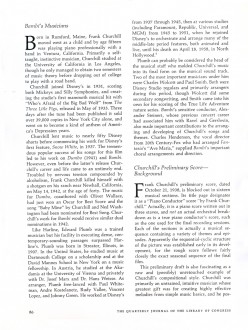 _
_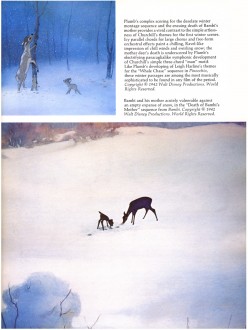 12
12
___________(Click any image to enlarge to a readable size.)
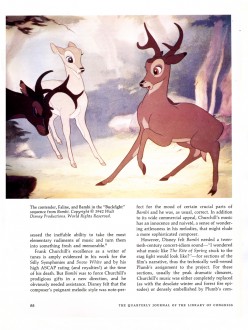 _
_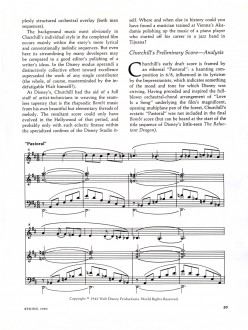 14
14
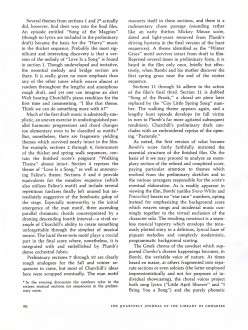 _
_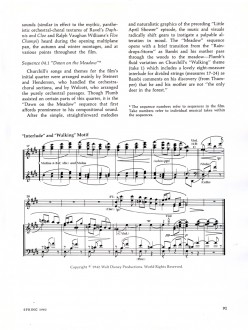 16
16
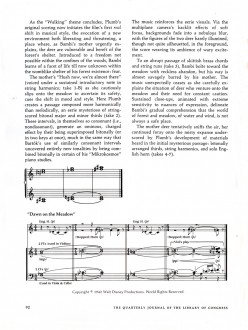 _
_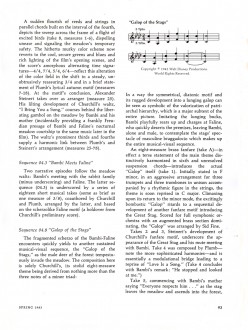 18
18
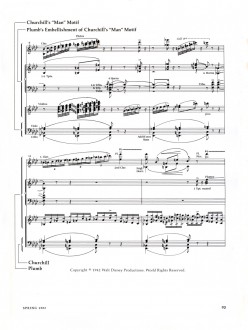 _
_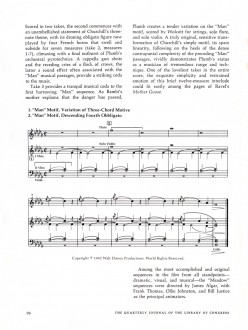 20
20
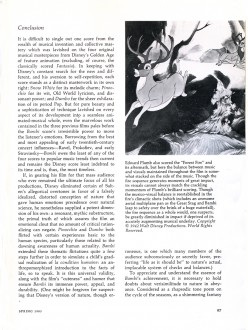 _
_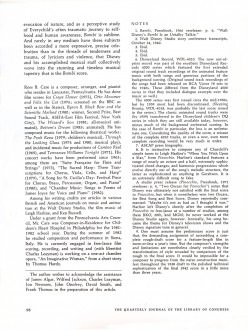 22
22
Article: Copyright © 1983 Ross B. Care
Articles on Animation &Festivals 21 May 2008 08:24 am
Product
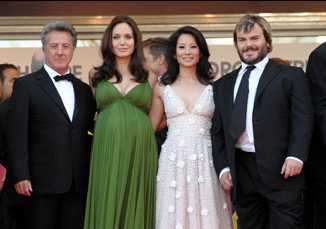 – This past weekend I came upon two reviews in one issue of Daily Variety. Kung Fu Panda and Waltz with Bashir were reviewed on the very same page. Both animated films are being presented in Cannes, and Variety reviewed them well in advance of their release (at least, in the U.S.).
– This past weekend I came upon two reviews in one issue of Daily Variety. Kung Fu Panda and Waltz with Bashir were reviewed on the very same page. Both animated films are being presented in Cannes, and Variety reviewed them well in advance of their release (at least, in the U.S.).
Kung Fu Panda didn’t receive a very positive notice: Chopsocky ‘Panda’ has bear necessities read the headline.
“Even by moppet-defined standards, _______The cast of Kung Fu Panda in Cannes.
the situations, characters and moti-
vations here are extremely elementary and lack nuance; other than Po and his prescribed transformation, none of the other figures reveal dimensions not fully evident at their initial appearances.” They went on to praise some of the graphics.
As for Waltz With Bashir, the reviewer said it is, “A subject that might, had it been made conventionally, have repped just another docu about a war atrocity, is tranmuted via novel use of animation into something special, strange and peculairly potent …”
The Hollywood product is designed to capatilize on the voices of Jack Black, Dustin Hoffman, Lucy Liu and Angelina Jolie. The other, Israeli made feature uses a mix of acted and documentary voices (including the director) and is subtitled.
 The reviews in Hollywood Reporter were almost identical to these in Variety.
The reviews in Hollywood Reporter were almost identical to these in Variety.
Of course, Kung Fu Panda will ulltimately have a large enough public in its Dreamworks distribution and will probably score $150-200 million. It was designed for commercial purposes to attract a large “family” (meaning “children”) audience.
Waltz With Bashir may not make it to the U.S. Variety said that U.S. distributors in Cannes are taking a “wait and see attitude” before buying into it.
________ Ari Folman _______.._.____That usually means that it has some problems.
_____________________.__________The film has sold to distribution in Spain, Germany, France and Greece. Writer/director, Ari Folman admits that the film is difficult to watch (it is about war) and cannot be changed to a happy ending movie.
The directors of Kung Fu Panda have worked in LA’s animation community. John Stevenson has been with Dreamworks for a while. Stevenson worked in storyboard on Madagascar, Sinbad and Spirit. He also directed episodes of the tv show, Father of the Pride. Mark Osborne has directed episodes of SpongeBob SquarePants prior to joining Dreamworks to direct on this film.
The director of Waltz With Bashir, Ari Folman, also wrote the film. He wrote and directed two other live action films and wrote episodes of “In Treatment”, the Israeli version of the show that transferred to HBO. His next film will be an animated adaptation of Polish author Stanislaw Lem’s “The Futurological Congress”. This time, he’ll make the animated feature in English.
I haven’t seen either film, obviously, though I’ve looked at a lot of clips. One is dyamically drawn with a lot of pop and snap to the animation – meaning there are no characters there. The other looks rotoscoped – more in the manner of the Chicago 10 than Waking Life. I’m getting discouraged again about the medium I love. But then, I’ve only seen clips. Perhaps they thought the poetic scenes wouldn’t attract audiences.
Here’s an article about the Kung Fu Panda party at Cannes.
Here’s a Cannes interview with director, Ari Folman.
Articles on Animation &Disney 20 May 2008 07:55 am
Bambi’s Music 1
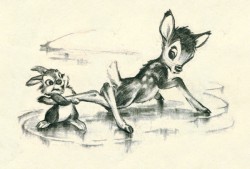 - I first met Ross Care years ago. He had scored the music to one of John Canemaker‘s early short films, The Wizard’s Son. I was impressed, and since I was looking for a composer for the first film of my new company, Byron Blackbear & The Scientific Method, I asked Ross for his help. He did a great job with little time and less money.
- I first met Ross Care years ago. He had scored the music to one of John Canemaker‘s early short films, The Wizard’s Son. I was impressed, and since I was looking for a composer for the first film of my new company, Byron Blackbear & The Scientific Method, I asked Ross for his help. He did a great job with little time and less money.
It was only a short time later, that I learned that Ross was an animation music historian. Somehow, we worked together in setting up a program for ASIFA East in which the conductor for Bambi, Alexander Steinert, took the stage with Ross to analyze the music for that film. I had a 16mm print of the film, and we watched about half of it. It was one of those memorable ASIFA meetings, that stay with you forever.
A year or two later, Ross had written an extensive article on Bambi’s music for The Quarterly Journal of The Library of Congress, the Spring 1983 edition. I just recently ran into the article on my shelves, and after getting Ross’ permission, I’m posting that article here. It’s 22 pages long, so I’ll have to post it in two parts.
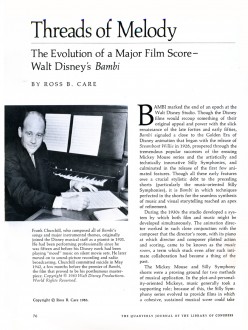 _
_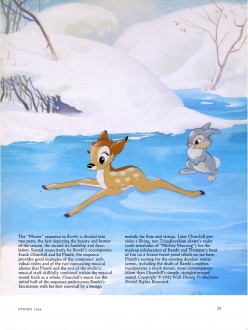 2
2
___________(Click any image to enlarge to a readable size.)
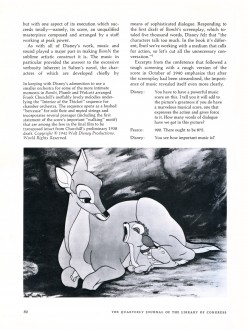 _
_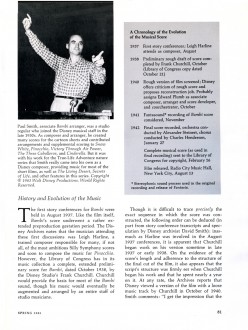 6
6
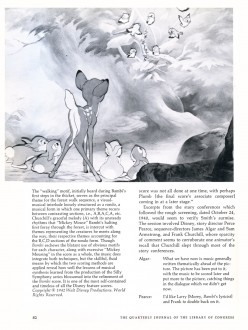 _
_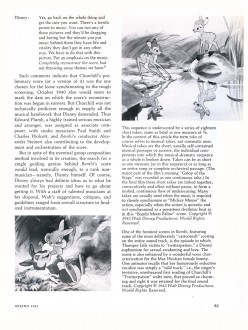 8
8
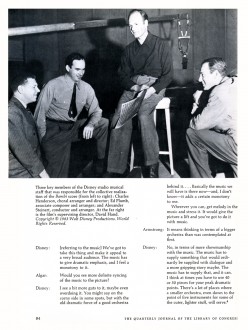 _
_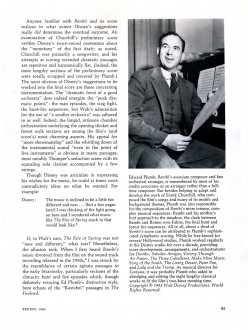 10
10
_________________________________________________To be completed Thursday.
Article: Copyright © 1983 Ross B. Care
Animation &Articles on Animation &Disney &walk cycle 22 Apr 2008 09:23 am
Little Girl w/puppy Walk
Today’s Wall Street Journal includes an excellent piece by John Canemaker about Ollie Johnston.
- I’ve been enjoying analyzing the walk cycles in 101 Dalmatians. I particularly liked the last one I posted “girl with french poodle.”
Here’s the young child with her puppy. She not only walks, but she licks her lollipop. The pup is just an absolute innocent. It’s another great walk by Blaine Gibson.
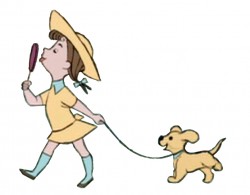 1
1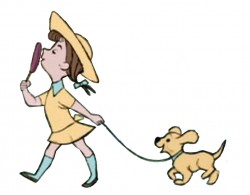 2
2
_______(Click any image to enlarge.)
The piece, in the film, includes a zoom into the cycle. I’ve tried to adjust for it but don’t think I was wholly successful. There’s a marginal enlargement of the drawings as it goes on – noticeable only in motion. It’s actually interesting in the walk.
Animation Artifacts &Articles on Animation &Commentary &Disney &Fleischer &Photos 20 Apr 2008 08:28 am
Howard Frank & Ollie and Creating Betty
Howard Beckerman sent me this great photo and a short letter attached to it. I can’t help but post both:
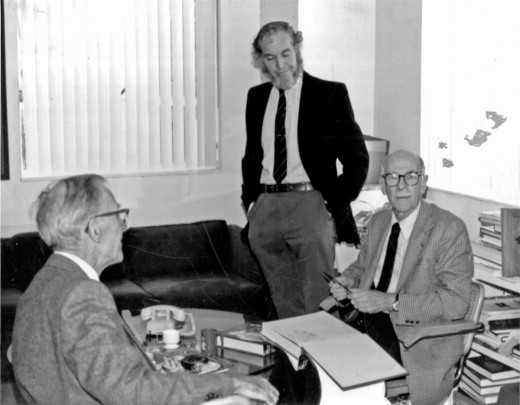
___________________________________________(Click any image to enlarge.)
Hi Michael,
Someone suggested that I send you this photo of Ollie signing my review copy of Disney Animation The Illusion of Life. It was taken in 1982 at the publisher’s office. Frank and Ollie were there with their wives. I was doing an interview to accompany a review of the book.
I brought my camera and the book, which in it’s large cardboard box stuck jauntily out of my shoulder bag. After the interview I more or less removed my interviewer’s hat and donned my Frank & Ollie fan hat and asked if they would sign the book. A publicity guy, standing in earshot, responded immediately saying, “Oh, you need a book? I’ll get you one.” I looked around and saw a pile of books about 5 1/2 feet high. “I brought my own I said,” assuming my best George Washington and the cherry tree stance. Ever since, then, I’ve thought that if I had left mine at home I could have had a second copy of this now valuable first edition.
I had met Frank Thomas before, but he introduced me to Ollie Johnston at the initial presentation of their book at the library at Lincoln Center. Ollie’s first statement to me after saying hello was, “Do you want to see my train?” He then pulled a picture of his backyard, full-size railroad rig from his wallet like a doting grandparent with a child’s snapshot.
Howard
- Mike Dobbs has a blog called Made of Pen & Ink. He was once the editor of Animato! 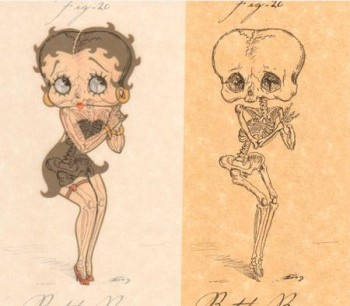 and Animation Planet, two fanzines for animation fans.
and Animation Planet, two fanzines for animation fans.
This blog is designed for Mike to post chapters of a book he’s writing about the Fleischer brothers entitled: Made of Pen and Ink: The Fleischer Studio and Cartoons.
It’s been a long time between chapters, and he’s just posted the third on this blog. It’s about Betty Boop and her history at the studio. If you haven’t kept up with it, this is a chance to read some heavy duty writing about Max & Dave.
____________An illustration by Michael Paulus.
Mike also has an animation blog wherein he reviews animated films and dvds. This, too, is worth checking out. Animation Review.
With all the nopstalgia in this post, I probably shouldn’t be adding a comment here, but it’s 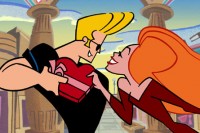 on my mind. I saw a few minutes of Johnny Bravo last night on cable tv. I never did warm up to this show, though I have to admit that watching it last night it looked a bit more golden.
on my mind. I saw a few minutes of Johnny Bravo last night on cable tv. I never did warm up to this show, though I have to admit that watching it last night it looked a bit more golden.
Compared to all the monstrously poor animation seen in the Flash shows, Johnny Bravo, as limited as it was, seemed richer and fuller. When a head turned it didn’t just pop from one side to another, it turned. When an arm had to move up, it didn’t just pop, it animated.
Have we reached the point where I miss even limited animation?
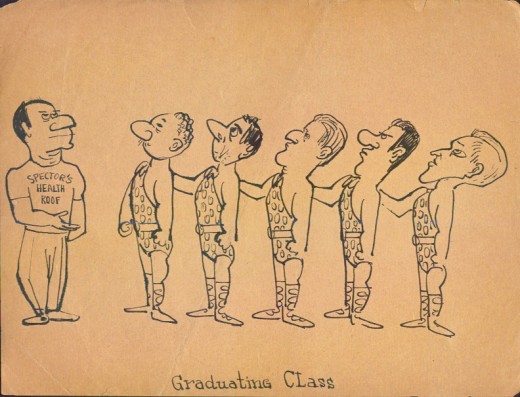
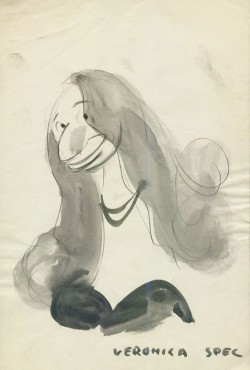
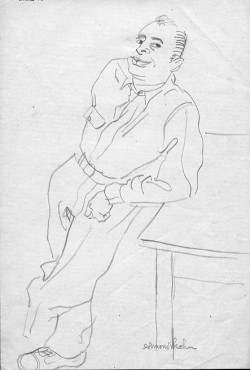
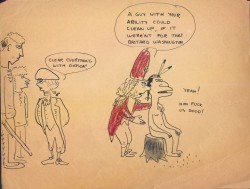
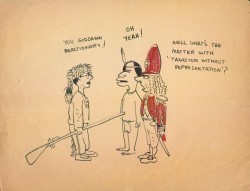
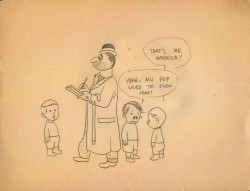
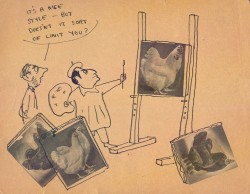
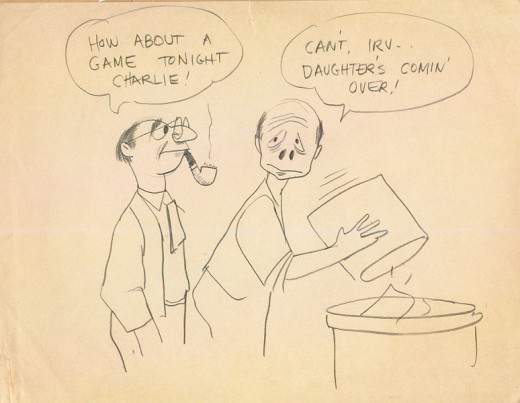
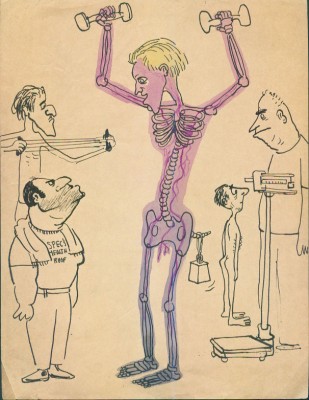
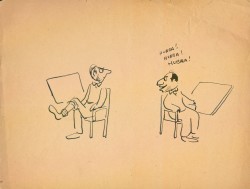
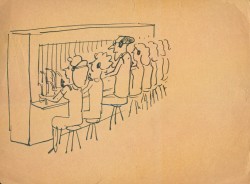
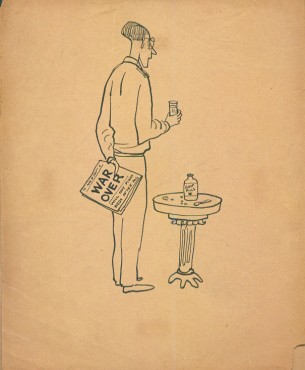
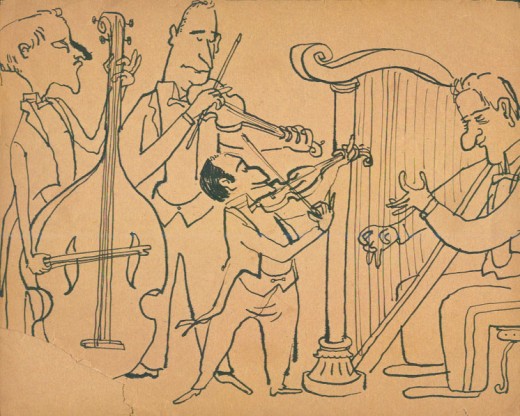

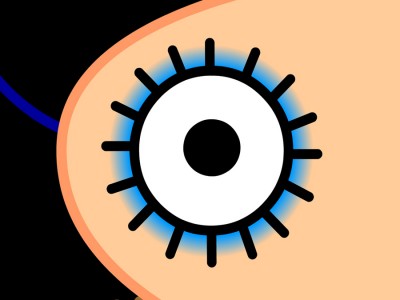
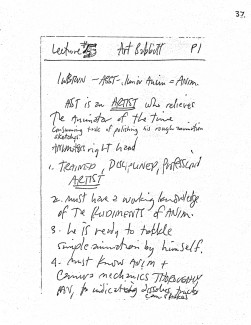 1
1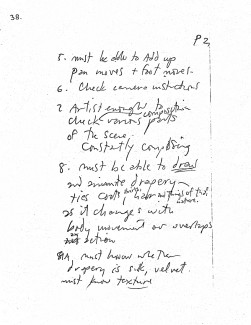 2
2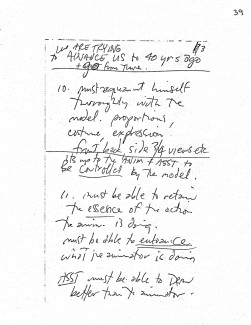 3
3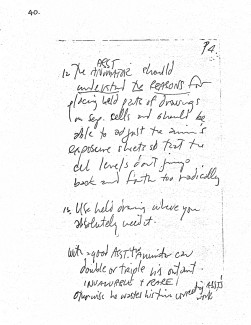 4
4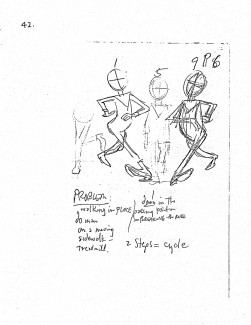 5
5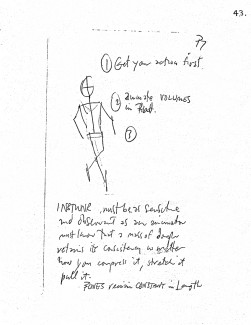 6
6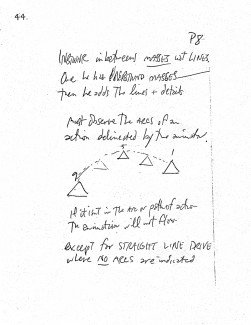 8
8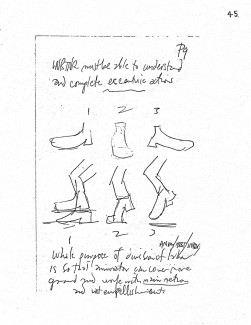 9
9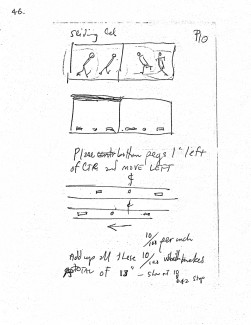 10
10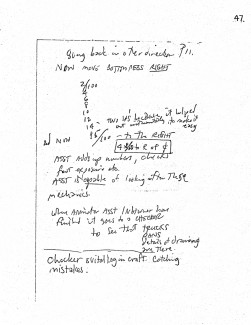 11
11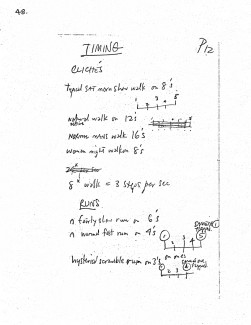 12
12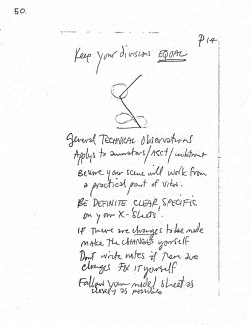 13
13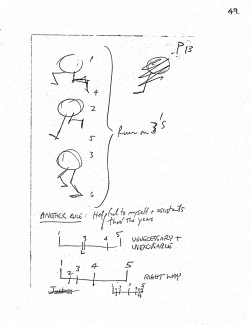 14
14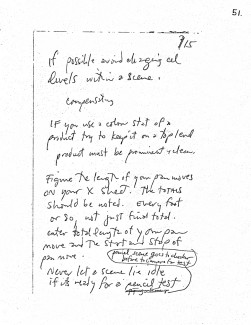 15
15 16
16 17
17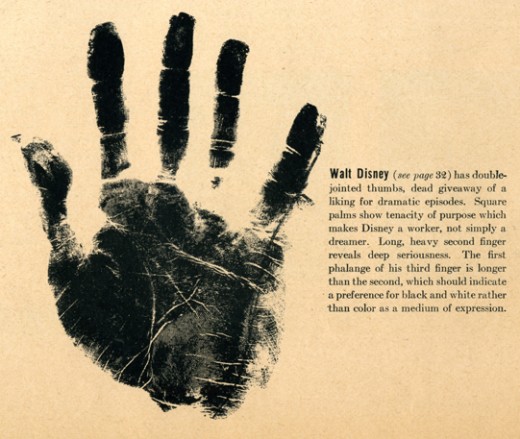
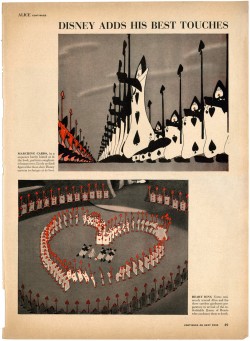 3
3 4
4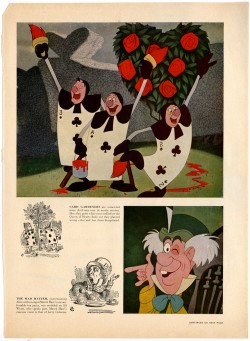 5
5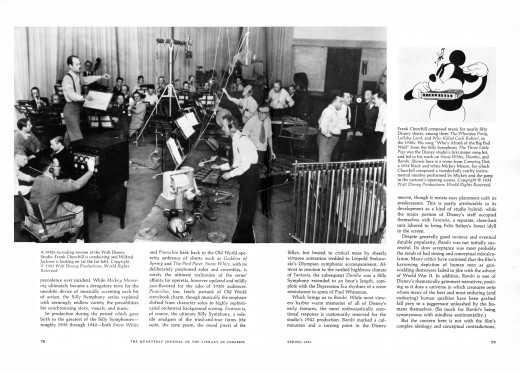 4
4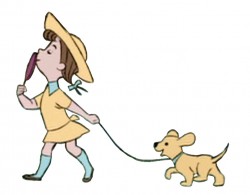 3
3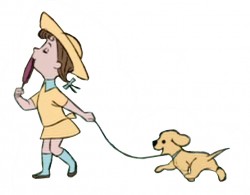 4
4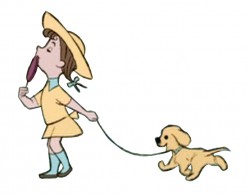 5
5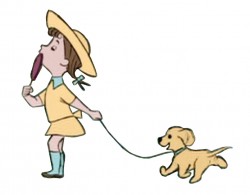 6
6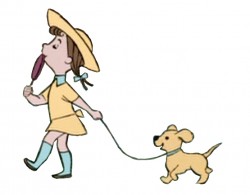 7
7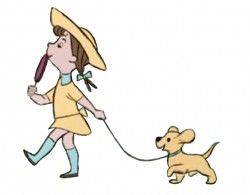 8
8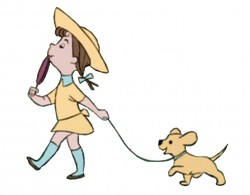 9
9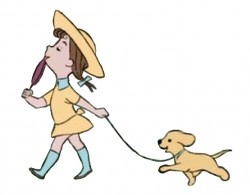 10
10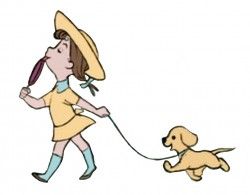 11
11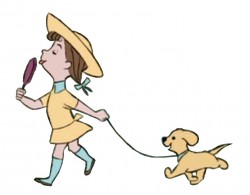 12
12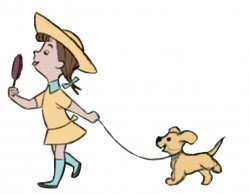 13
13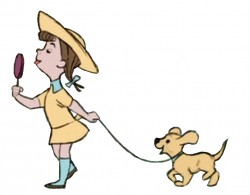 14
14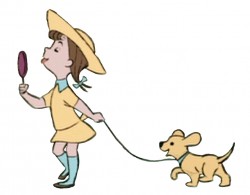 15
15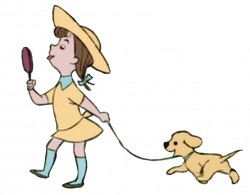 16
16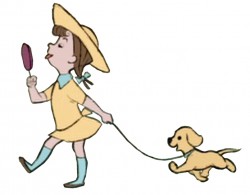 17
17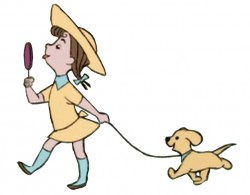 18
18